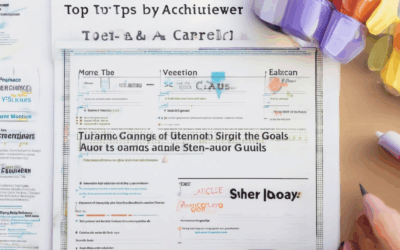Staying productive while working from home can be a daily challenge, especially when distractions abound and motivation fluctuates. Whether you’re juggling multiple tasks, managing remote teams, or simply trying to maintain focus, finding the right balance is crucial. In this article, we’ll explore proven productivity rules and strategies that can help you master your workflow, regardless of your workspace. From understanding the 1-3-5 Rule to discovering how to stay productive while working from home, we’ll cover actionable tips and techniques that can transform your approach to work. By learning how to implement effective time management practices and maintain a healthy work-life balance, you’ll unlock the secrets to long-term success and increased efficiency. Let’s dive into the world of productivity hacks and redefine how you approach your professional endeavors.
Key Takeaways
– Master the 52/17 Rule: Balance focused work intervals of 52 minutes with 17-minute breaks to maintain productivity and prevent burnout.
– Leverage the 80/20 Principle: Prioritize 20% of tasks that yield 80% of results to boost efficiency and achieve your goals faster.
– Adopt the 8-8-8 Productivity Formula: Divide your day into three 8-hour segments—dedicated to work, sleep, and leisure—to achieve a healthy work-life balance and optimal performance.

The 1-3-5 Rule for Maximizing Productivity
The 1-3-5 rule is a simple yet effective productivity strategy that helps individuals manage their time more efficiently. This method categorizes tasks based on urgency and importance, allowing you to prioritize effectively.
How the 1-3-5 Rule Works
- One Major Task: Focus on one critical responsibility that requires the most attention and has the highest impact. Complete this task first to set the foundation for the rest of your day.
- Three Medium-Tier Tasks: These are important but less urgent responsibilities. Allocate about 30 minutes to complete these tasks. They should be manageable and require moderate focus.
- Five Minor Tasks: These are quick, low-priority activities that take minimal time. Handle these during downtime or breaks to stay productive without overexerting yourself.
Why the 1-3-5 Rule is Effective
This rule is particularly useful for busy individuals who struggle to balance multiple responsibilities. By breaking down your tasks into these categories, you can avoid feeling overwhelmed and maintain a sense of accomplishment throughout the day.
Implementing the 1-3-5 Rule Successfully
- Prioritize Tasks Daily: Review your schedule each morning to identify your major, medium, and minor tasks for the day.
- Set Time Limits: Allocate specific time blocks for each category to ensure you stay on track.
- Adjust as Needed: Flexibility is key. If certain tasks take longer or become more urgent, be willing to adjust your priorities accordingly.
Real-Life Applications
Imagine you’re a project manager overseeing several deadlines. Your major task might be finalizing a report, your medium tasks could involve coordinating with two team members, and your minor tasks might include responding to emails and attending brief meetings.
By applying the 1-3-5 rule consistently, you can significantly boost your productivity and reduce stress. Remember, the goal is to work smarter, not harder.
For more tips on mastering time management, explore our Time Management Strategies guide or learn how to Balance Work and Life effectively.
How to Stay Productive at the Workplace
Staying productive at work requires a combination of effective strategies, discipline, and a positive mindset. Here are some proven techniques to help you achieve peak performance:
1. Set Clear Goals
Start your day by defining your priorities and objectives. Write down what you aim to accomplish and break tasks into manageable steps. This will give you a roadmap to follow throughout the day.
2. Manage Time Effectively
Use time management tools like calendars, task lists, or project management software to organize your workload. Prioritize tasks based on urgency and importance, focusing on high-impact activities first.
3. Leverage Productivity Tools
Utilize tools and technologies that can streamline your workflow. Whether it’s productivity apps, collaboration software, or automation tools, these can save you time and reduce errors.
4. Practice the Pomodoro Technique
Work in focused intervals of 25 minutes (Pomodoro) followed by a short break (5 minutes). This method helps maintain concentration and prevents burnout.
5. Maintain a Healthy Work-Life Balance
Take regular breaks, eat nutritious meals, and ensure you get enough sleep. A well-rested mind is more productive. Incorporate physical activity and mindfulness practices to recharge your energy.
6. Embrace Continuous Learning
Stay updated with industry trends and skills by dedicating time to learning and professional development. This not only boosts your expertise but also keeps your mindset fresh and motivated.
7. Collaborate and Communicate Effectively
Work closely with colleagues to share knowledge and resources. Effective communication fosters teamwork and ensures that everyone is aligned toward common goals.
8. Stay Organized
Keep your workspace clutter-free and use filing systems to manage documents. Digital tools like cloud storage can help you access information quickly and efficiently.
9. Avoid Common Productivity Pitfalls
Minimize distractions like unnecessary meetings, social media, or personal tasks. Dress appropriately for work and maintain a professional demeanor to stay focused.
10. Seek Feedback and Improve
Regularly ask for feedback from supervisors or peers to identify areas for improvement. Constructive criticism can help you grow and enhance your performance.
By implementing these strategies, you can significantly boost your productivity and contribute meaningfully to your organization. Remember, consistency and adaptability are key to long-term success.

The 333 Rule for Productivity
The 333 rule is a productivity strategy designed to optimize your workflow by balancing work intervals with adequate breaks. Here’s a breakdown of how it works:
- Understanding the 333 Rule :
- The rule suggests working for 50 minutes followed by a 10-minute break. This cycle repeats throughout the day.
- The name “333” refers to the combination of work and break times (e.g., 3 hours of work + 30 minutes of break = 3:30, hence 333 minutes in a 12-hour workday).
- Benefits of the 333 Rule :
- Prevents mental fatigue and burnout by avoiding long work intervals.
- Enhances focus and productivity by allowing the brain to reset during breaks.
- Promotes a healthier work-life balance, reducing stress levels.
- Steps to Implement the 333 Rule :
- Set a timer for 50 minutes of focused work.
- Take a 10-minute break during which you can relax or perform light tasks.
- Repeat the cycle until your workday ends.
By following the 333 rule, you can maintain a productive rhythm while caring for your well-being, ultimately leading to sustainable productivity levels.

The 52/17 Rule for Productivity
The 52/17 rule is a popular time management strategy designed to maximize productivity by balancing work intervals with short breaks. Here’s a breakdown of how it works and why it’s effective:
- Work Interval:** 52 minutes – This is the duration you dedicate to focused work without distractions. During this time, you should concentrate on high-priority tasks and avoid switching between tasks.
- Break Duration:** 17 minutes – After every 52 minutes of work, take a 17-minute break. This short downtime allows your brain to rest, recharge, and return to work with renewed focus and energy.
This rule is based on the idea that sustained focus leads to better productivity, but frequent breaks help maintain cognitive function and creativity. By following the 52/17 ratio, you can sustain peak performance over longer periods without experiencing burnout or fatigue.
To implement this rule effectively:
- Use a timer to track your work and break intervals.
- Stick to the schedule consistently to build momentum.
- During work time, minimize interruptions and focus solely on the task at hand.
By adopting the 52/17 rule, you can optimize your workflow, enhance productivity, and maintain a healthy balance between work and relaxation. This approach is particularly useful for individuals who need to manage multiple tasks while maintaining high levels of focus and efficiency.
The 80/20 Rule for Productivity
The 80/20 rule, also known as the Pareto Principle, is a simple yet powerful concept that can significantly enhance productivity. This principle states that 80% of any outcome is typically produced by 20% of the effort. When applied to productivity, it means that 80% of your results come from 20% of your actions.
Understanding the 80/20 Principle
The Pareto Principle is often used in various fields, including business and personal productivity. In the context of productivity, it suggests that you should focus on the 20% of activities that generate the majority of your results. By identifying these high-impact tasks, you can maximize efficiency and achieve your goals faster.
Examples of Applying the 80/20 Rule
- Task Prioritization : Identify the 20% of tasks that contribute to 80% of your objectives. Focus your energy on these critical tasks first.
- Time Management : Allocate 20% of your time to activities that yield the highest returns. Use tools like the Eisenhower Matrix to categorize tasks by urgency and importance.
- Efficiency : Automate or delegate 80% of your routine tasks to free up time for high-value work. Tools like software automation or outsourcing can help streamline processes.
Benefits of the 80/20 Approach
- Increased Productivity : By focusing on the most impactful tasks, you can achieve more in less time.
- Improved Results : Concentrate your efforts on activities that matter most to your goals.
- Reduced Stress : Minimizing low-priority tasks can reduce overwhelm and increase job satisfaction.
Maximizing Productivity with the 80/20 Rule
To effectively apply the 80/20 rule to productivity:1. Identify High-Impact Tasks : Assess which tasks contribute most to your success.2. Eliminate Low-Priority Work : Delegate or eliminate tasks that don’t align with your priorities.3. Leverage Technology : Use tools and automation to handle repetitive or low-value tasks.4. Set Clear Goals : Define measurable objectives to guide your focus.
By embracing the 80/20 rule, you can unlock your full potential and achieve unprecedented levels of productivity.

The 8-8-8 Rule of Productivity Explained
The 8-8-8 rule is a simple yet effective strategy for optimizing productivity, health, and overall well-being. This method suggests allocating your day into three equal segments of 8 hours each:
- Work : Dedicate 8 hours to focus on your professional responsibilities and goals. This ensures you’re fully engaged and committed to your tasks during prime working hours.
- Sleep : Prioritize 8 hours of quality sleep. Adequate rest is essential for cognitive function, emotional stability, and physical health. It plays a vital role in rejuvenating your body and mind.
- Leisure : Reserve the remaining 8 hours for hobbies, relaxation, and personal time. Engaging in activities you enjoy helps reduce stress, boosts mood, and provides a sense of fulfillment.
This rule emphasizes balance, aiming to prevent burnout by ensuring adequate time for work, rest, and personal interests. By maintaining this equilibrium, individuals can enhance their productivity while taking care of their mental and physical health.
Why the 8-8-8 Rule Works
- Promotes consistent energy levels throughout the day.
- Reduces the risk of chronic stress and fatigue.
- Enhances creativity and problem-solving abilities.
- Fosters a healthier lifestyle by prioritizing sleep and leisure.
Implementing the 8-8-8 Rule Effectively
- Create a daily schedule that aligns with your personal rhythm.
- Set clear boundaries between work and personal time.
- Experiment with flexible arrangements if needed, as individual needs may vary.
By following the 8-8-8 rule, you can achieve a more balanced and fulfilling life while maintaining high productivity levels. Remember, consistency and adaptability are key to long-term success.




0 Comments